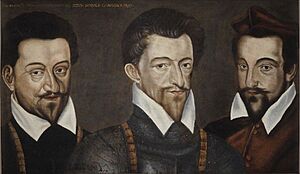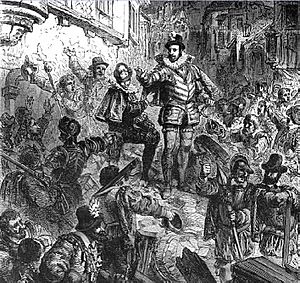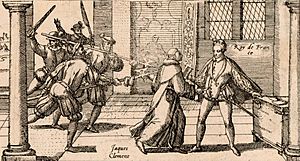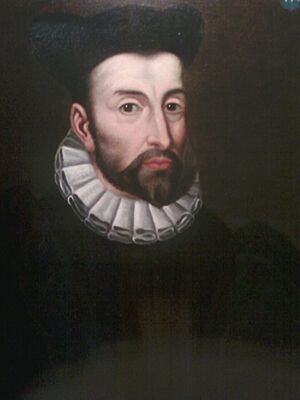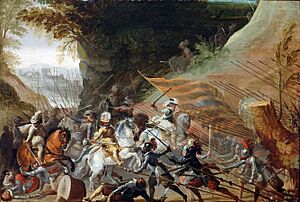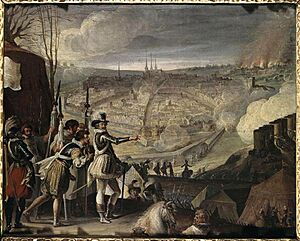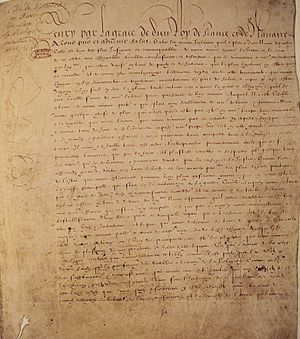Charles, Duke of Mayenne facts for kids
Quick facts for kids Charles de Lorraine |
|
|---|---|
| Duke of Mayenne | |
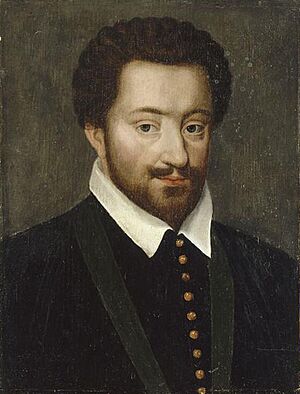 |
|
| Born | 26 March 1554 Alençon |
| Died | 3 October 1611 (aged 57) Soissons |
| Spouse | Henriette de Savoie-Villars |
| Issue | Renée de Lorraine, duchess of Ognano Henri de Lorraine, duke of Mayenne Charles Emmanuel de Lorraine, count of Sommerive Catherine de Lorraine |
| House | House of Lorraine |
| Father | François de Lorraine, duke of Guise |
| Mother | Anne d'Este |
| Signature | |
Charles de Lorraine, Duke of Mayenne (born 1554, died 1611) was an important French noble. He was a governor, a military leader, and sometimes a rebel during the French Wars of Religion. These were a series of conflicts between Catholics and Protestants in France.
Charles was the second son of François, Duke of Guise. When his father died in 1563, Charles inherited the important role of Grand Chambellan (a high position in the king's household). He fought in battles like the siege of Poitiers in 1569. He also went on a military expedition against the Ottomans in 1572.
During the siege of La Rochelle in 1573, he was wounded. He also became the governor of Bourgogne when his uncle died. His title of Marquis of Mayenne was raised to a duché pairie (a higher noble rank) that same year. Charles was a key figure in the Catholic League, a group of Catholics who fought against the Protestant heir to the throne. He played a major role in the political and military struggles of his time.
Contents
Early Life and Family
His Family and Siblings
Charles de Lorraine was born in 1554. His parents were François, Duke of Guise and Anne d'Este. He had an older brother, Henri de Lorraine, born in 1549. He also had a younger brother, Louis de Lorraine, born in 1554. His elder sister was Catherine de Lorraine.
Marriage and Children
In 1576, Charles married Henriette de Savoie-Villars. She was a very rich heiress. Her marriage brought him a large amount of money and land in the southwest of France. Her father also promised that Charles would become the Admiral of France when he died. This was the second most important military job in France.
Charles and Henriette had four children:
- Renée de Lorraine (died 1638)
- Henri de Lorraine, Duke of Mayenne (1578–1621)
- Charles Emmanuel de Lorraine, Count of Sommerive (1581–1609)
- Catherine de Lorraine (1585–1618)
His Character
Charles de Lorraine was not very interested in the strict religious life that was popular at the king's court. He was known for his strong will and military skills.
Military Service and Rise to Power
Serving King Charles IX
When his father died in 1563, Charles inherited the role of Grand Chambellan. This meant he was in charge of the king's household. He held this position until 1589.
Charles first saw military action during the third War of Religion. He and his older brother, Henri, helped defend Poitiers in 1569. They fought against the Protestant army led by Admiral Coligny. Charles and Henri successfully defended the city. This delay allowed the king's brother, Anjou, to arrive with the main royal army.
In 1572, Charles went on a military expedition against the Ottomans. He served with the Venetians for a while.
Governor of Bourgogne
In March 1573, at just 19 years old, Charles became the governor of Bourgogne. He took over after his uncle, Claude de Lorraine, died in battle at La Rochelle. The Lorraine family had controlled Bourgogne since 1543. In September 1573, King Charles IX made Charles's title of Marquis of Mayenne into a duché-pairie. This was a higher noble rank.
Charles traveled with Anjou, who was elected king of the Commonwealth. He stayed in Anjou's court for several months. Charles wanted to be more involved in governing Bourgogne than his uncle had been.
Under King Henri III
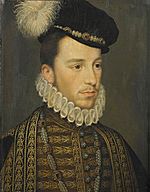
In May 1574, King Charles IX died. His brother Anjou became King Henri III of France. Charles de Lorraine and his family played an important part in Henri III's coronation. Charles, his brother Henri, and their cousin Aumale acted as the three lay peers for the ceremony.
In 1575, Charles led a royal army against a Protestant mercenary force. His army, however, was poorly funded and suffered from hunger. They could not stop the Protestant forces from joining with the king's brother, Alençon.
The First Catholic League
In May 1576, King Henri III was forced to make a generous peace with the Protestants. Many Catholics, including Charles, were very unhappy with this. They formed the Catholic League to oppose the peace. The League quickly grew across France.
The League soon forced Henri III to break the peace, starting the sixth civil war in 1577. Charles was among those who wanted to continue the war. He helped lead a royal army that besieged and captured La Charité-sur-Loire and Issoire. Later, he captured the town of Brouage on the Atlantic coast. The Treaty of Bergerac ended the conflict in September.
Despite some tensions with the king's favorites, Charles was allowed to take over the office of Admiral in 1578. Henri III seemed to favor Charles more than his brother, perhaps to create divisions within the Lorraine family.
Charles commanded a royal army during a short civil war in 1580. He captured the Protestant stronghold of La Mure. After the peace treaty, he successfully ensured that other towns submitted to the king.
However, Charles did not keep the Admiral's office for long. In 1582, Henri III gave it to his favorite, Joyeuse. Charles received a large payment and other honors in return. In 1583, he was involved in plans to invade England, but these plans failed due to lack of money.
The Second Catholic League
A major crisis happened in June 1584. The king's brother, Alençon, died. This meant that the next in line to the throne was Navarre, a Protestant. Many Catholics, including Charles and his family, found this unacceptable.
In September 1584, Charles, his brother Henri, and other family members formed a second Catholic League. They wanted Cardinal Bourbon, Navarre's Catholic uncle, to be the next king. In December, they made an alliance with Philip II of Spain. Charles and his brother signed this treaty. Charles used his power as governor of Bourgogne to gather support for the League.
The League had two main parts: the nobles, led by Charles's family, and the middle-class citizens in cities like Paris. While his brother Henri was alive, he managed to keep these two groups together. But after Henri's death, Charles struggled to maintain this unity.
War Against King Henri III
In March 1585, Charles's brother Henri openly rebelled against the king. Charles quickly took control of major cities in his governate, including Dijon, Mâcon, and Auxonne. In July, King Henri III was forced to sign a humiliating peace treaty. He agreed to most of the League's demands, including a war against Protestantism. Charles was given Beaune as a surety town and control of the Château of Dijon.
Charles actively fought against the Protestants in the south. However, King Henri III was not fully committed to the war. Charles became frustrated by the lack of funds and support for his army.
In May 1588, King Henri III tried to regain control of Paris. But radical Catholics in the city rebelled, forcing the king to flee. This event is known as the Day of the Barricades.
The king was forced to make more concessions to the League. He agreed to appoint Charles and his brother Henri to lead his main armies against the Protestants. At the Estates General of 1588 (a meeting of representatives from different parts of society) called later that year, the Third Estate (commoners) demanded that money they offered be given directly to Charles.
Assassination of the Duke of Guise

King Henri III, feeling humiliated, made a drastic decision. In December 1588, he arranged for the assassination of the Duke of Guise and Cardinal Guise. This act caused widespread rebellion across the kingdom.
Charles was in Lyon at the time. He narrowly escaped arrest by the king's agents. He quickly returned to his governate and hired Swiss soldiers. He then traveled to Paris, gathering support for the League along the way.
Charles Becomes Lieutenant-General
In February 1589, Charles was appointed lieutenant général de l'État et Couronne de France (Lieutenant-General of the State and Crown of France) by the League's government in Paris. This gave him broad authority, almost like a king. He began raising an army and collecting taxes. He also helped reorganize city administrations to suit the League's goals.
Charles worked to bring important nobles, like Nevers, to the League's side. However, Nevers remained loyal to the king.
Rebellions in Cities
After the assassinations, about half of France's largest cities joined the League. Charles was deeply involved in many of these rebellions.
- Rouen: In February 1589, Rouen had its own "Day of the Barricades" and joined the League. Charles visited Rouen to set up a League council. He preferred a government led by nobles, unlike the more citizen-led government in Paris.
- Toulouse: This city also joined the League. Charles's appointee, Joyeuse, secured the city for Charles's moderate faction of the League.
- Troyes: Charles arrived in Troyes with his troops. All officials had to swear loyalty to the League. He set up a council to govern the city.
- Champagne: Charles appointed the young Duke of Guise as governor of Champagne. He also appointed other trusted leaders to manage the province.
- Dijon: In his own governate of Bourgogne, Charles had strong support. He worked to influence local elections to favor his political interests.
Charles led a new army of over 10,000 men. He captured Vendôme, causing concern for the king. In April, Charles's forces fought a skirmish where 50 League members were killed, but a royalist leader was captured.
King Henri III, facing rebellion, allied with his Protestant heir, Navarre, in April 1589. They planned to march on Paris together. Charles almost captured the king in a surprise attack at Tours in May. Henri escaped, and Charles was forced to withdraw. Charles then moved into Normandie, capturing Alençon.
Charles tried to stop the combined forces of Henri III and Navarre from reaching Paris. But they captured strategic towns like Pontoise. By the end of July, the royalists were besieging Paris. Charles desperately sought help from Spain.
Under King Henri IV
A New King
On August 1, 1589, King Henri III was assassinated. This was a huge opportunity for Charles and the League, as the Protestant Navarre was now the king, Henri IV. Charles tried to convince cities that had remained loyal to join the League. Some of Henri III's former favorites even switched sides to Charles.
Charles abolished the League's Grand Conseil in its original form. He reshaped it into an advisory council under his leadership.
Battles of Arques and Ivry
Henri IV moved north into Normandie. Charles chased him, vowing to defeat him. The two armies met at Arques in September 1589. Charles suffered a significant defeat.
In March 1590, the two sides clashed again at Ivry. Charles's army of 18,000 men was larger than Henri's 13,000. But Charles was defeated again. He lost his standard (flag) of Lorraine.
After Ivry, Henri IV moved to besiege Paris. The siege caused great hardship in the city. Charles could not lift the siege alone. He received help from Spanish forces led by the Duke of Parma. Together, they forced Henri to abandon the siege.
After the death of Cardinal Bourbon in 1590, the League needed a new candidate for the throne. Charles considered his own claim, but Paris preferred the young Duke of Guise. Spain supported Isabella Clara Eugenia, the daughter of Philip II.
Dealing with Radicals
In November 1591, radical members of the League in Paris executed three moderate leaders, including Barnabé Brisson, the head of the Paris Parlement. Charles was furious. He entered Paris and ordered the execution of those responsible. He also imprisoned other radical League members.
Normandie became a major battleground. In early 1592, Henri IV besieged Rouen. Charles was reluctant to confront the combined royal and English army. However, the Duke of Parma arrived and forced Henri to lift the siege. Charles and Guise entered Rouen in triumph.
Estates General of 1593
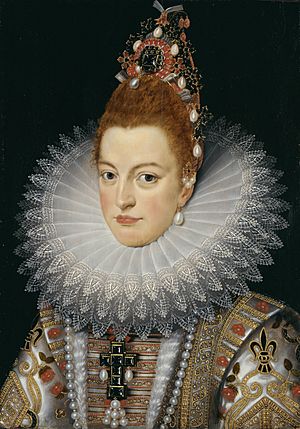
In late 1592, Charles was pressured by Spain and radical League members to call an Estates General. This meeting was meant to confirm the claim of the Spanish Infanta (princess) to the French throne. Charles reluctantly agreed.
Charles gave the opening speech, emphasizing the need for a Catholic king. Henri IV, though not recognizing the Estates, tried to communicate with its moderate members. In May, Henri announced his plan to convert to Catholicism. This caused great confusion in the Estates. The Spanish proposals for their princess to rule France were not popular. Henri's conversion removed a major obstacle to his acceptance as king.
By 1593, many radical League members were unhappy with Charles. They felt he was too moderate. Charles, in turn, was frustrated by their extreme views.
The Fall of Paris and Reconciliation
The war was going badly for Charles and the League. In February 1594, Lyon and Orléans fell to Henri IV. Charles left Paris on March 6, 1594. Henri IV entered Paris on March 22, with the help of the city's governor. The new government quickly took control. Charles's authority as lieutenant-general was officially removed.
Charles continued to fight, using his control of Bourgogne as leverage. He convinced Spain to send another army. Together, they harassed Henri IV's forces. However, Henri captured Laon, forcing Charles to retreat to Bourgogne.
Battle of Fontaine-Française
In 1595, Henri IV sent his general, Biron, to crush Charles in Bourgogne. Biron had great success, capturing several towns. Henri IV then awarded the governorship of Bourgogne to Biron.
A Spanish army invaded Bourgogne to help Charles. They met a part of Henri IV's army at Fontaine-Française. Charles recognized Henri IV on the battlefield and tried a cavalry charge, but it was repelled. The Spanish commander was too cautious and withdrew his forces.
Peace with the King
After the defeat at Fontaine-Française, Charles left the Spanish camp. He began serious talks to reconcile with Henri IV. In the Edict of Folembray in September 1595, Charles pledged his loyalty. He was granted three towns (Chalon, Seurre, and Soissons) for six years. He also received the governorship of Île de France (though without control over Paris) and a large sum of money. However, he lost his power base in Bourgogne.
Charles formally submitted to Henri IV in January 1596. He knelt before the king and denounced the Spanish influences that had led him astray. Henri IV embraced him. The king then took Charles on a fast walk through the gardens, leaving Charles out of breath. Henri joked that this was the only revenge he would take on his cousin.
Now loyal to the king, Charles worked to bring other family members, like his distant cousin Mercœur, back to the royal side.
Siege of Amiens
By 1597, the war in France was mostly against Spain. Philip II of Spain had taken control of several French cities, including Amiens. Henri IV laid siege to Amiens. Charles de Lorraine, now a royalist, fought alongside the king. He was happy to show his skills as a strategist. In an interesting turn, Charles was now fighting against his cousin, Aumale, who fought for the Spanish. The royal army captured Amiens in September.
Edict of Nantes
In 1598, Henri IV issued the famous Edict of Nantes. This edict granted rights to Protestants. However, it made exceptions for cities given to former League leaders, including Charles. This meant these areas did not have to allow Protestant worship. When some Catholics asked Charles to overturn the edict, he refused, as he was now loyal to the king.
As a reward for his loyalty, Henri IV gave Charles's eldest son the title of Duke of Aiguillon in 1599.
Death
Charles de Lorraine attended Henri IV's royal council more often in the early years of the king's reign. But as time went on, he attended less frequently. He died in 1611 in Soissons. His son, Henri, succeeded him as Duke of Mayenne.
See also
 In Spanish: Carlos de Lorena para niños
In Spanish: Carlos de Lorena para niños
- Love's Labour's Lost - Charles served as the basis for the character of Dumaine in the play.


